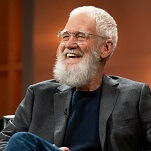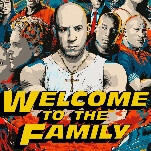Spoiler Space offers thoughts on, and a place to discuss, the plot points we can’t disclose in our official review. Fair warning: This article features plot details of Wake Up Dead Man.
If we were to judge the quality of Rian Johnson’s Knives Out films by how surprising we find the ultimate reveal of their killers, they wouldn’t be much to write home about. Three entries into the case files of Southern private detective Benoit Blanc (Daniel Craig), each of the murderous masterminds—who remain opaque until the very last second—has been the most suspicious and likely culprit, and they all set themselves apart with asshole behavior that feels stereotypical to their stock-character type. In Knives Out, it was the spoiled, cynical trust-fund manchild Ransom Drysdale (Chris Evans); in Glass Onion, it was the arrogant, insecure, false prophet tech guru Miles Bron (Ed Norton).
In Wake Up Dead Man, it’s Martha Delacroix (Glenn Close), a devout Catholic and church caretaker who is characterized less by buffoonery and more a severe, unfriendly intensity that positions her far closer to Rebecca‘s Mrs. Danvers than Glass Onion‘s riff on Elon Musk. Nevertheless, Martha’s caricaturish traits mark her as an obvious object of suspicion, thus the Knives Out culprit pattern continues. Three films in and Johnson’s bait-and-switch-and-back-to-bait plotting is clearly working as intended, a strategy designed to include as many complications, eccentric personalities, and thematically blunt jokes as possible between the story’s initial question and the much-anticipated answer.
The Knives Out films therefore imply that not only is uncovering the method of murder more entertaining than the identity of the murderer, but also—with their middle-class echo chamber ensembles—that culpability stretches far further than one single killer. “Hell, any of them could have done it,” read the poster of Knives Out back in 2019; the only thing separating suspects and killers is tenacity. If morbid gumption is the sole sin that propels selfish, wicked people to become murderers, then it’s less of a critique that all the Knives Out culprits have shared a certain flair for obvious cartoonishness.
Wake Up Dead Man does break slightly from tradition, as the obnoxious, domineering masculine presence is reserved not for the murderer but rather the victim. Josh Brolin’s Monsignor Wicks is a shaggy bearded, unflinching despot in a small, upstate New York Catholic parish. His flock is meager (limited to the exact size of a Knives Out sequel poster), and he maintains his dogmatic hold by alienating newcomers, airing their dirty laundry, and shaming their personal misdemeanors, prompting them to flee in outrage and uniting his followers in a shameful but ecstatic bond of complicity (which in turn encourages them to continue financially supporting his parish).
The relationship between Martha and Wicks is sketched out in clear, graspable shorthand: The central contradiction of being his most devout follower but still orchestrating his murder rings true, as she likely believes in his messaging more than Wicks does. Wicks seems into it more for the power trip—as evidenced by his recurring, detailed descriptions of masturbation when taking confession with the recently appointed junior priest Jud Duplenticy (Josh O’Connor).
Martha is pushed to murder when she realizes that conservative YouTuber and wannabe politician Cy Draven (Daryl McCormack) is Wicks’ illegitimate son and the pair are planning to break free from the parish with a lost fortune courtesy of Wicks’ priest grandfather. Intent on preserving Wicks’ legacy, if not his mortality, Martha presses Dr. Nat Sharp (Jeremy Renner), a recently divorced alcoholic, and her groundskeeper husband Samson (Thomas Haden Church) to enact her plan. Wicks is poisoned, then stabbed in the back in plain view of the whole congregation. Then Samson is dressed up like Wicks and buried in his crypt to retrieve Wicks’ grandfather’s jewel. Finally, Samson emerges from the tomb to look like a resurrected Wicks on the security cameras. As with all perfect crimes, it doesn’t go to plan—Jud stumbles across the resurrection, Nat kills Samson to claim the diamond for himself, and Martha kills Nat by tricking him into drinking pentobarbital, only to poison herself and deliver a deathbed confession just as Blanc discovers the solution.
This is both stupidly convoluted and a pleasure to witness. For the first time in three films, Benoit is well-matched with his co-protagonist: O’Connor is a formidable comedic talent who pitches himself at the exact right notes to challenge and compliment Craig’s thickly applied pontificating schtick, and his internal struggle with guilt and imperfection (as spurred by the his hatred of Wicks’ definition of faith) makes him the most dramatically robust point-of-view character in the series so far. He is embedded in (and rejected by) the parish before the murder happens, and his presence convincingly upsets the murderer’s plot.
But the problem with watching so much of the scheme unfold in real time is that it extends the time that Jud and Benoit must passively react or receive information. In prioritizing a maddening, deliciously complicated plot, the film denies its detectives a convincing sense of agency. It is not that the truth eludes them, but they are too often in an impossible state of ignorance, catapulted into the unknown by dramatic developments. Apart from leaving several high-caliber cast members without much to do (Kerry Washington, Cailee Spaeny, and Andrew Scott are hung out to dry), interrupting the investigation with an entire film’s worth of off-screen scheming—which the detectives need to grasp just before the final curtain call—denies the audience the steady, scintillating process of actually solving a mystery.
These reveals and heel turns suffer from being shown in part and then explained fully later in the story; like a good process-driven crime thriller, Martha’s scheme would be best enjoyed unfolding in real time with all its necessary context. As it stands, it’s too dense to appreciate in reported flashbacks and narrated exposition. It’s an admirable way to plot out an improbable crime, but Wake Up Dead Man‘s mystery functions first and foremost as a rug-pull contraption, evoking a chaotic chess match viewed solely from the limited perspective of a plucky pawn.
Who feels like the most powerful agent of Wake Up Dead Man? It’s not Benoit Blanc, nor is it Jud, the film’s emotional center. Rather, it’s writer-director Rian Johnson’s authorial thumbprint that is present within every character choice, plot twist, narrative cul-de-sac, and red herring, mixing the motions of his mystery with his desire to undermine his audience’s certainty until everything breathlessly falls into place.
None of these impulses are new or even improper for a murder mystery, but the problem with Johnson’s storytelling is that the suspense is driven less by strategic gaps in information and plausibility but by big structures of plot and backstory that linger outside of our purview only to be discovered just in time for a final, hefty dump of exposition. The balance is off, and Johnson doesn’t integrate Jud’s character arc (absolving his guilty, flighty conscience through faith) with a mystery he is increasingly sidelined from—symbolized by him spending the third act convinced that he killed Samson.
Johnson’s familiarity with murder-mystery conventions is evident—Wake Up Dead Man cites its locked-room mystery and unreliable narrator sources, mentioning The Hollow Man by John Dickson Carr and The Murder Of Roger Ackroyd by Agatha Christie. Riding the high of Knives Out, Johnson teamed up with Natasha Lyonne for the spiritual follow-up series Poker Face, where Lyonne plays a Columbo-vibed woman blessed with an ability to detect when someone is lying. Poker Face also apes the structure of Columbo, where we know who the killer is before the investigation begins—not a whodunnit, but a howcatchem. Inverting the narrative in this way allows the detective work to flourish; the suspense comes from a fear that the detective won’t discover what we already know.
Granted, these episodes wrap up in 50 minutes, and clocking in around 130 minutes each, the Knives Out films require a meatier source of tension than an episode of television. “Who killed this person?” remains an undefeated method of hooking an audience. Yet, as luridly entertaining as these films are (save the occasional eye-rolling piece of cultural commentary too labored to work), they are too committed to getting in their way.
Watching these films, there’s an inevitable twinge of disappointment near the halfway mark when Johnson announces that a new overwhelming mode of storytelling is taking over, leaving the traditional detective work in the dust. Being convoluted, loud, and too cute for their own good is now the house style for a Knives Out mystery, an exercise in branding worthy of their Netflix home—but one that comes at the cost of clean, rigorous, and satisfying mystery storytelling.
That Wake Up Dead Man goes to lengths to dial down the garish pop satirical tone of Glass Onion proves that the sheer scale of its mystery design is an insurmountable issue: At this stage, it feels impossible for the series to dial back its ambitions and flourishes, as Johnson is too set on a frenetic visual style and a hot-button sense of humor. But if we are to judge these films not by who the killer is but how we get to the final reveal, we deserve a smoother ride.








































